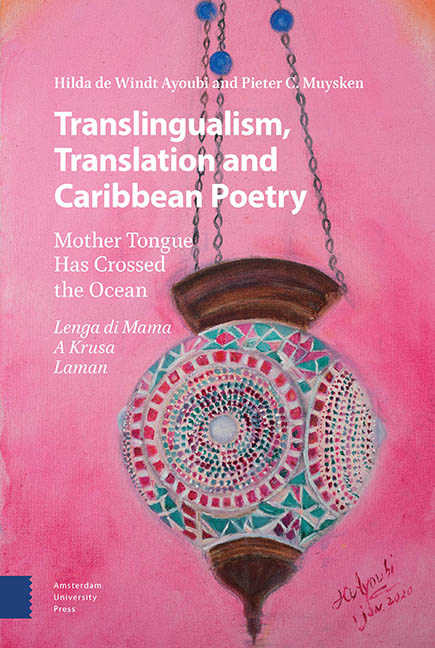Book contents
- Frontmatter
- Dedication
- Contents
- How to Navigate This Book: Kon Nabegá den e Buki akí
- Acknowledgements
- Preface
- Part 1 Introducing the Mother Tongue: Introdukshon di Lenga di Mama
- Part 2 The Poem “Lenga di Mama” and its Translations, Comments and Language Descriptions E Poema “Lenga di Mama” i su Tradukshonnan i Komentario i Deskripshon di e Idiomanan
- Part 3 The Poem “E ‘papiá’ di Papiamentu” and its Translations E Poema “E ‘papiá’ di Papiamentu” i su Tradukshonnan
- Part 4 The Poem “Papiamentu pa Semper” and its Translations E Poema “Papiamentu pa Semper” i su Tradukshonnan: The Translations and Editing of the Poem Hilda de Windt Ayoubi and Pieter Muysken (for Dutch)
- Part 5 The Poem “Riba Ala di Lenga di Mama” and its Translations E Poema “Riba Ala di Lenga di Mama” i su Tradukshonnan
- Part 6 Commentary: Komentario
- Note on the Authors: Informashon tokante e Outornan
- Index: Índise
How to Navigate This Book: Kon Nabegá den e Bukiakí
Published online by Cambridge University Press: 15 September 2022
- Frontmatter
- Dedication
- Contents
- How to Navigate This Book: Kon Nabegá den e Buki akí
- Acknowledgements
- Preface
- Part 1 Introducing the Mother Tongue: Introdukshon di Lenga di Mama
- Part 2 The Poem “Lenga di Mama” and its Translations, Comments and Language Descriptions E Poema “Lenga di Mama” i su Tradukshonnan i Komentario i Deskripshon di e Idiomanan
- Part 3 The Poem “E ‘papiá’ di Papiamentu” and its Translations E Poema “E ‘papiá’ di Papiamentu” i su Tradukshonnan
- Part 4 The Poem “Papiamentu pa Semper” and its Translations E Poema “Papiamentu pa Semper” i su Tradukshonnan: The Translations and Editing of the Poem Hilda de Windt Ayoubi and Pieter Muysken (for Dutch)
- Part 5 The Poem “Riba Ala di Lenga di Mama” and its Translations E Poema “Riba Ala di Lenga di Mama” i su Tradukshonnan
- Part 6 Commentary: Komentario
- Note on the Authors: Informashon tokante e Outornan
- Index: Índise
Summary
The reader of this book may wonder why, instead of theusual number of one or two languages for the prefaceand acknowledgements, six different languages areincluded in these sections. The first reason issimply that this book contains more than fiftytranslations of the main poem “Lenga di Mama”;adding these six languages in the opening sectionsof the publication builds on that consistency withthe idea of translingualism. The second reason, andperhaps the more important one, is that it reflectsthe language situation in the Dutch CaribbeanLeeward Islands, Aruba, Bonaire, Curaçao, where fivelanguages, namely Dutch, English, French,Papiamento, and Spanish, are included in the presentschool curriculum. A sixth language, Greek, was alsoincluded because it used to be part of thecurriculum at the secondary level in Curaçao, andalso because it was my wish to include one languagewith different letter signs. Moreover, approximatelyseven-teen percent of the vocabulary of thelanguages included in our curriculum are of Greekorigin.
As for the choice of translations of the poem “Lenga diMama”, one important criteria was that at leastfifty percent of the languages would be a minorityand/or an endangered language. In addition, then, atleast one translation from each language familywould be a minority language.
The other fifty percent of larger languages would thenserve as promoting media and information to theminority ones. It was our idea to include languagesfrom each continent. However, due to unforeseenCovid-19 circumstances, it was not possible toinclude indigenous languages of Australia.
Regarding the sequence of languages, instead ofalphabetically ordering the languages from eachlanguage family, we opted for a more visualstructure, that is, a more or less geographicalorder, moving mostly from north to south. For theCreole languages, we departed from the Caribbean,that is from Curaçao, the island where Papiamento isspoken, moving first towards the northern islands ofGuadeloupe, Haiti and Jamaica, then southwards tothe more southern islands, finally to Suriname forthe language of Sranantongo. After this, weproceeded to the West Coast of Africa for the CapeVerdean language, and finally to the Indian andPacific Ocean Creole languages.
- Type
- Chapter
- Information
- Translingualism, Translation and Caribbean PoetryMother Tongue Has Crossed the Ocean, pp. 13 - 14Publisher: Amsterdam University PressPrint publication year: 2022



